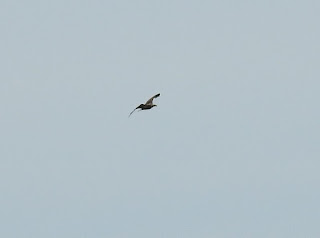** Brian and Valerie Bauld visited the Tantramar Marsh on Thursday. They
spotted a ROUGH-LEGGED HAWK [Buse pattue] perched near the intersection of the
High Marsh Rd. as they approached from Aulac. They then came across two adult
BALD EAGLES [Pygargue à tête blanche], on utility poles, and one kilometer later
down the High Marsh Rd. noted an immature Bald eagle on a pylon. Shortly after an adult Bald Eagle came flying to the juvenile and chased it
lower on the pylon and then the juvenile took its leave. Brian captured this
scenario in three excellent action photos.
** Stacey Lee Foreman got a photo of a LYNX [ lynx ] near Wolfe Lake at
Fundy National Park last weekend. It was placed on Facebook, an alert to it
forwarded by George Sinclair, a retired Fundy National Park warden. The Lynx is
not a commonly seen animal in south-eastern New Brunswick.
** Anna Tucker visited the Sackville Waterfowl Park on Monday. A few of her
photos show the surprising amount of open water for late February.
** With weather predictions as they are we may not see it again this week but Brian Stone got a nice photo of a full Moon with bright Jupiter at its side at 8:44 pm on Tuesday evening, as well as a photo of the full Moon nicely showing its features. Jupiter is the brightest object in the sky at the moment, after the Sun and Moon.
** With weather predictions as they are we may not see it again this week but Brian Stone got a nice photo of a full Moon with bright Jupiter at its side at 8:44 pm on Tuesday evening, as well as a photo of the full Moon nicely showing its features. Jupiter is the brightest object in the sky at the moment, after the Sun and Moon.
( Transcriber's comment ... The Moon was actually one day past full, which
occurred on Monday at 2:20 pm )
** We recently distributed a photo of a gull from Brian Stone and labelled
it second winter ICELAND GULL [Goéland arctique]. There have been several
interesting comments on this photo. Some more attention to eye color does show
it as yellow, which one photo did not show well. A second photo does, to
indicate it is a second winter bird. However, whether it be an Iceland Gull or a
GLAUCOUS GULL [Goéland bourgmestre] is the identification query. Both second
winter Iceland and Glaucous gulls have a black bill tip and yellow eye. The
Glaucous Gull tends to have a shorter primary projection, that is to say the
projection of the wing feathers p9 and p10 past the tail tip, than the Iceland
Gull. The bill of the Glaucous is overall larger than the Iceland Gull, and its
head is more flattened and less rounded than the Iceland Gull. The Glaucous Gull
is significantly larger than the Iceland Gull, but a lone bird prevents that
from being a deciding factor. Suffice to say, this particular bird may be a hard
one to call for certain. We are going to re-label it as a Glaucous Gull suspect.
An excellent gull identification learning scenario. The re-labeled photos, and
additional photos of the same bird, are attached for your gull viewing pleasure.
Gulls are interesting birds, but not usually the identification challenge that
this one posed.
Nelson Poirier,
Nature Moncton
BALD EAGLE INTERACTION.FEB 23 2016.BRIAN BAULD
BALD EAGLE INTERACTION.FEB 23 2016.BRIAN BAULD
BALD EAGLE JUVENILE DEPARTURE.FEB 23 2016.BRIAN BAULD
LYNX.FEB 2016.STACEY LEE FOREMAN
MOON AND JUPITER. FEB. 23, 2016. BRIAN STONE
MOON. FEB. 23, 2016. BRIAN STONE
SACKVILLE WATERFOWL PARK.FEB 22, 2016..ANNA TUCKER
GLAUCOUS GULL (2ND WINTER). FEB.19, 2016. BRIAN STONE,
GLAUCOUS GULL (2ND WINTER). FEB.19, 2016. BRIAN STONE,
GLAUCOUS GULL (2ND WINTER). FEB.19, 2016. BRIAN STONE,
SACKVILLE WATERFOWL PARK.FEB 22, 2016..ANNA TUCKER










